Samothrace › Cassander » Ancient origins
Articles and Definitions › Contents
- Samothrace › Ancient History
- Cassander › Who Was
Ancient civilizations › Historical and archaeological sites
Samothrace › Ancient History
Definition and Origins
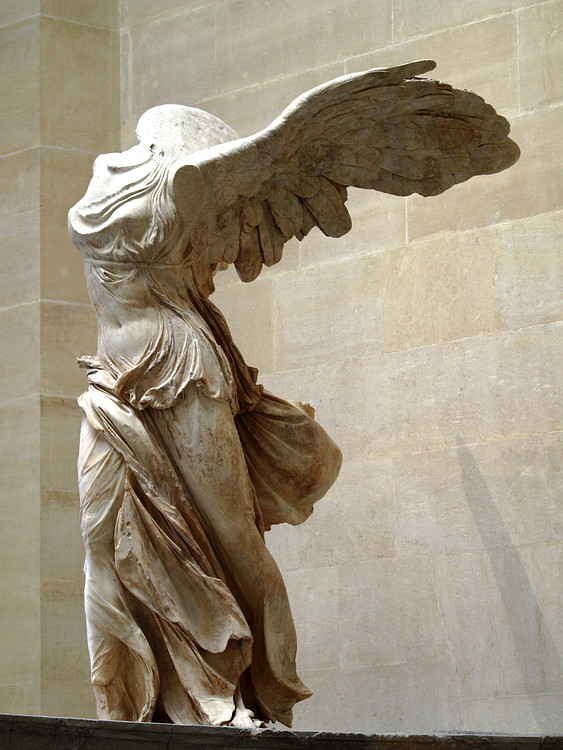
Samothrace (Samothrake) is a Greek island in the northern Aegean which was prominent from the Classical period as a member of the Delian League. Its greatest claim to fame was as a cult centre favoured by Macedon and visited by pilgrims from across the Aegean. Its name today is best known for the magnificent Hellenistic Nike sculpture, the Nike of Samothrace, excavated on the island in the 19th century CE, which is now on display in the Louvre, Paris.
ARCHAIC & CLASSICAL PERIODS
Samothrace, a mountainous Aegean island with an area of 178 km², was first inhabited in the Neolithic period and then colonized by Greek settlers c. 700 BCE, probably from Samos. In literature, Samothrace appears in Homer ’s Iliad when Poseidon settles himself on the island's mountaintop to watch the spectacle of the Trojan War unfold. The city was ruled by five tribes who had Athena as their patron, and they minted their own coins. In the Persian Wars, we know that at least one ship fought on the side of the Persians (and sunk an Athenian ship) during the Battle of Salamis (480 BCE). Nevertheless, following Greek victory, Samothrace was a tribute-paying member of the Delian League, the alliance of Greek city-states led by Athens, from 478 to 404 BCE. In the same period the island controlled a territory ( peraea ) on the Thracian mainland where colonies were established. Following a brief period when the island fell under the control of Sparta, Samothrace attracted the interest of Macedon.
HELLENISTIC & ROMAN PERIODS
Samothrace's importance increased dramatically when it received the patronage of the royal house of Macedon, a status which continued through the Hellenistic period. The sanctuary on the island was probably dedicated to the Cabiri (or Kabitoi, perhaps Hermes and Hephaistos here) or the undefined deities known as the Great Gods ( Theoi Megaloi, most prominent among them here was likely Axieros, later identified with Demeter ). These gods were the focus of a mystery cult which was prevalent across the northern Aegean. According to Herodotus (Bk. 2.52) the cult had been introduced to the island by the Pelasgians centuries earlier.
THE CULT OF THE GREAT GODS ON SAMOTHRACE WAS SECOND ONLY TO THE ELEUSINIAN MYSTERIES IN IMPORTANCE IN THE GREEK WORLD.
The cult was second only to the Eleusinian Mysteries in importance in the Greek world. Pilgrims came from afar to seek protection (especially from the sea), moral improvement, a long-life, and a better afterlife. As the name suggests the details of the ceremonies involved at Samothrace remain a mystery, but we do know that first-time initiates ( mystai ) did whatever they did blindfolded while those already initiated were known as epoptai or 'viewers'. Ceremonies were performed at night and involved dancing. We also know that there was no class, wealth, or nationality barrier to participating in the mysteries and both women and slaves were eligible too.
The Macedonians funded large building projects on the island and it grew to such importance that many Greek city-states sent ambassadors ( theoroi ) and some of these would remain as proxenoi or permanent residents who looked after the interests of their city at the site. During the Successor Wars following Alexander the Great ’s death the island switched hands between various Hellenistic rulers but continued to attract visitors to its sanctuary. In the Roman period Samothrace was made a free city giving it certain privileges regarding tax and political autonomy. Part of the Byzantine empire until 1204 CE, it then came under Genoa's rule and was fortified. From the 15th century CE Samothrace was ruled by the Ottomans.

Temple of the Great Gods, Samothrace
ARCHAEOLOGICAL REMAINS
The sanctuary, located at the northern end of the island, was first systematically excavated in the 1930s CE by American archaeologists showing that it once covered 12.5 hectares. This revealed the remains of the largely 4th and 3rd-century BCE buildings and temples. The large temple dates to c. 340 BCE and once had a frieze of dancers, the shrine structure was likely where the mysteries were performed, and the Tholos of Arsione (288-281 BCE) was dedicated by Arsione, wife of Lysimachus, to the Great Gods. Completing the most important buildings to be seen today, there is a large propylon(monumental gate) dedicated by Ptolemy II Philadelphus in 285-281 BCE, a 3rd-century BCE stoa (colonnaded building), and a palace-like structure dating to the 1st century BCE.
THE NIKE OF SAMOTHRACE
However, it is an earlier discovery, made in the 19th century CE, which has brought Samothrace worldwide fame. This is the magnificent marble statue of Victory known as the Nike of Samothrace. The statue was dedicated by worshippers at the cult sanctuary following a naval victory. Dating to c. 190 BCE, the goddess has powerful wings spread and seems to have just landed on a ship's prow. She was set up above an artificial lake at the sanctuary for an even greater dramatic effect. The Nike, considered one of the masterpieces of Hellenistic sculpture, is now on permanent display in the Louvre museum in Paris, France.
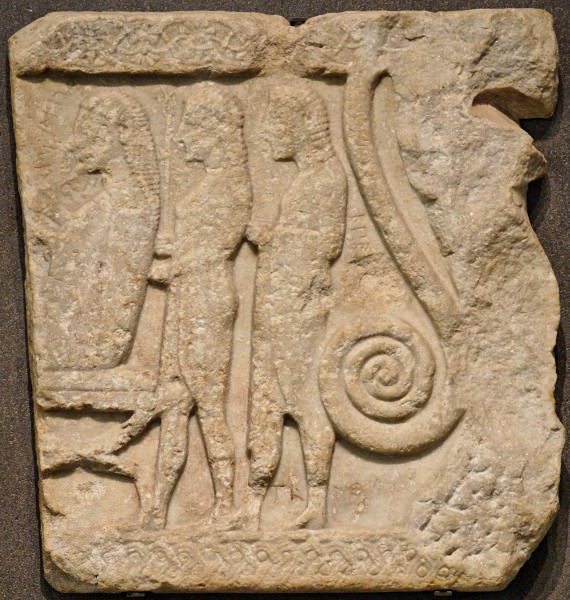
Agamemnon, Relief of Samothrace
Other finds at the site include pottery and stone monuments with Thracian inscriptions. Seals from the Minoan civilizationsuggest contact with Crete in the Middle Bronze Age. There are fragments of the temple frieze and finds from tombs such as coins and jewellery which are all on display at the site museum. Finally, a famous relief sculpture from the island, also now in the Louvre, depicts a procession of Agamemnon, a herald, and Epeios (maker of the Trojan Horse) who are identified by an inscription. Dating to c. 550 BCE, the scene is an unknown episode from the Trojan War and a reminder that our knowledge of Greek mythology is far from complete.
Cassander › Who Was
Definition and Origins
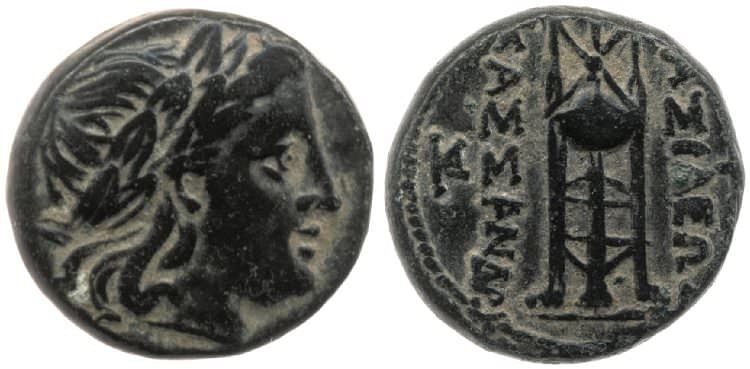
Cassander (c. 355-297 BCE, r. 305-297 BCE) was self-proclaimed king of Macedon during the political turmoil following Alexander 's death. Born in Greece as the son of Antipater, the regent of Macedon and Greece in the absence of Alexander the Great, he ruled beside his father eventually battling against the commander Polyperchon for supremacy in Greece. His alliance with Seleucos I and Ptolemy I against Antigonus I brought him into the Wars of Succession, the battle over the remnants of Alexander's domain. His murder of Alexander's mother and son ended any hope for an heir to the king's empire.Cassander's death in 297 BCE would, for a time, bring stability, but without an heir, his beloved Macedon would fall into the hands of others.
EARLY LIFE
Throughout his campaign against the Persians, Alexander the Great remained aware of the many troubles plaguing his homeland of Macedon. Although the regent Antipater was able to suppress a rebellion staged by Agis II of Sparta, he was unable to prevent Alexander's mother, Olympias, from constantly complaining to his son about the regent's supposed abuse of power. She despised Antipater, and he referred to her as a "sharp-tongued shrew." Finally, Alexander opted to listen to his mother and summon Antipater to Babylon. Believing it to be a death sentence, he chose instead to send his son Cassander.Alexander was not pleased, and the conflict that ensued may have brought about the king's early death.
Cassander and Alexander were not strangers; however, it became obvious many years later that they were not close friends.They were both about the same age and, along with Ptolemy and Hephaestion, students of the great Athenian philosopher Aristotle. Now, the year was 323 BCE, and as Cassander stood before his king intending to make a valiant plea on his father's behalf, he witnessed several Persians prostrating themselves before Alexander - an old Persian custom called proskynesis. His immediate reaction was to laugh. The historian Plutarch in his Greek Lives wrote, "… he could not stop himself laughing, because he had been brought up in the Greek manner and had never seen anything like that before."Alexander grew irate and "grabbed hold of Cassander's hair violently with both hands and pounded his head against the wall " (378). The image of this brutal attack would remain with Cassander for years to come and whenever he would see a statue or painting of the king, he would faint. Plutarch wrote of this malady,
… when he was king of Macedonia and master of Greece, he was walking around Delphi looking at the statues, when he suddenly glimpsed a statue of Alexander and became so terrified that his body shuddered and trembled, he nearly fainted at the sight and it took a long time for him to recover. (379)
ALEXANDER'S DEATH
On June 10, 323 BCE Alexander the Great died. Since that time, arguments and rumors have persisted concerning the possible cause - malaria, an old wound, his alcoholism, or even poisoning. This latter cause was something Olympias wholeheartedly believed. However, the rumor of poisoning, regardless of any direct evidence, brought into the conversation the names of Cassander, his brother Iolaus, Antipater, and even Aristotle. Supposedly, according to rumor, Aristotle, on the orders of Antipater, obtained the poison from a spring that flowed into the River Styx; Cassander carried it to Babylon in the hoof of a mule; and it was delivered to the king by Iolaus, Alexander's cupbearer. Plutarch did not give credence to the poison rumor.Later, Antipater made every attempt to defend himself against the rumors in order to win the hearts of the Greek people.

Alexander the Great
After Alexander's death, the empire he had so fearlessly built fell into chaos. And, while the commander Perdiccas possessed both the king's signet ring and body - the commander Ptolemy would later kidnap the body - no one had been named as either the successor or heir; however, it was accepted that Alexander's child by Roxanne, the future Alexander IV, would one day rule. Alexander's half-brother Arrhidaeus, son of Philip II and Philinna, was named Philip III and chosen to rule as co-regent until young Alexander was old enough to rule alone. Meanwhile, although there was no child to consider, Roxanne, to affirm her status as Alexander's only wife, poisoned Darius ’s daughter (and Alexander's wife) Stateira and threw her body into a well - she also killed the sister Drypetis for no apparent reason. Since the future Alexander IV was yet to come of age, the commanders resorted to arguing among themselves, concerned more with gaining regency over a portion of the empire than appointing a successor.
WARS OF SUCCESSION
At a meeting held in Triparadeisus presided by Antipater in 321 BCE, the vast empire was divided among the various commanders. The more notable assignments confirmed in the agreement were: Ptolemy had Egypt, Seleucus Babylonia, Lysimachus had Thrace, while Antigonus ruled much of Asia Minor. Lastly, Antipater retained his regency over Macedonia and Greece. Alliances were made, and alliances were broken. Over the next three decades, the Wars of Succession brought nothing but chaos and confusion. In the end, Alexander IV, his mother, and even Olympias would be dead, and the once great empire of Alexander would die with them.
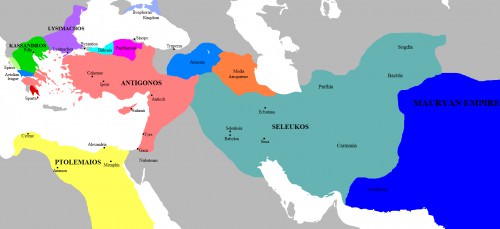
Map of the Successor Kingdoms, c. 303 BCE
Antipater and Cassander realized that their tenuous hold on Greece and Macedonia was not safe. With little recourse, they looked to the other commanders for support eventually forming an alliance with Antigonus the One-eyed. Antigonus has sought Antipater's help after he and Perdiccas argued - Antigonus had refused to help the Perdiccas' ally Eumenes in a fight to retain his territory. Eumenes had been declared an enemy of the state at Triparadeisus and condemned to death. However, Cassander wisely grew to be suspicious of the old commander's intentions. Antipater acknowledged his son's concern, and the two met with Antigonus. According to their agreement, Antigonus lost control of much of his veteran army; they were replaced by newer recruits. When Antipater and Cassander returned to Macedon, Antigonus gathered his forces and defeated Eumenes in 321 BCE. In the same year, Perdiccas would be defeated in a battle against Ptolemy and killed by his own men. Several years later, when Cassander gained control over Macedon and most of Greece, the cagey commander and old veteran would clash. For now, however, he stayed cautious.
CASSANDER AS CHILARCH
Cassander remained loyal to his father to the very end, but when Antipater died in 319 BCE, he failed to name his son as his heir. He felt Cassander too young and inexperienced to rule alone and defend against the other regents. Instead, Antipater named the capable commander Polyperchon. Cassander was named chilarch or second in command. Of course, the two would immediately clash. Something that may have influenced Antipater's decision comes from Cassander's childhood. He had always been a sickly child, and it was a Macedonian custom that a boy had to kill a wild boar without a net to gain the privilege of reclining at a table as an adult. Cassander never did and had to sit upright on his couch even as an adult. Despite his new role as chilarch, Cassander would not remain idle long and sought alliances elsewhere. Eventually, despite his misgivings, he looked across the Hellespont and allied himself with Antigonus.
DESPITE HIS NEW ROLE AS CHILARCH, CASSANDER WOULD NOT REMAIN IDLE LONG AND SOUGHT ALLIANCES ELSEWHERE. EVENTUALLY, DESPITE HIS MISGIVINGS, HE ALLIED HIMSELF WITH ANTIGONUS.
Fearing this alliance, Polyperchon looked southward to the Greek city -states for support, promising them their independence from Macedonian rule; however, they had to promise not to wage war against Macedon. The struggle between the two escalated, centering on the city-state of Athens. Wisely, at the time of Antipater, Cassander had sent an emissary to Athens to ensure the city's loyalty. Later, in 318 BCE, when tensions with Polyperchon escalated, Cassander negotiated with the city, restoring its old oligarchy. To win favor with the city-states, he even rebuilt the old city of Thebes which had been destroyed by Alexander. In 317 BCE, to ensure his hold on the region, the confident Cassander established a base at Pegeus, southwest of Athens. Suffering a major defeat at Megalopolis, Polyperchon became entrapped in the Peloponnese. All the while, he continued to insist that Antipater had given him the regency, not Cassander.
With little hopes of achieving success in the city-states, Polyperchon turned northward, seeking the support of Olympias in Epirus, eventually hoping to march on Macedon, overthrow Philip II and install Alexander IV as king. Regrettably, Philip III and his wife Eurydice (also known as Adea), who had sided with Cassander and appointed him regent, were captured - and, on the orders of Olympias, he would be murdered in 317 BCE - Eurydice would commit suicide.
Despising Cassander as she had his father, Olympias quickly joined with not only Polyperchon but Eumenes as well. However, realizing the inevitable, soldiers once loyal to Polyperchon soon wavered in their support and chose to surrender and join Cassander. Added to the defeat of Eumenes, this abandonment did not help Olympias, Roxanne, and the young Alexander who were now isolated at Pydna. Polyperchon's attempts to contact her by letter or aid in an escape failed, leaving the old queen both hungry and in despair. However, Cassander, although seeking a fair trial stated that he would not harm her, in the end he received the death sentence he had always sought.
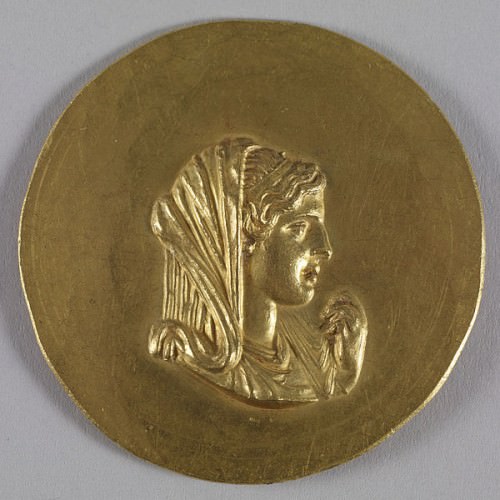
Olympias
In 316 BCE he sent soldiers to kill her, and in fine Olympias fashion, she bled to death while preparing her hair and clothes.With Olympias dead, the young Alexander had no protector. To Cassander he and his mother represented a mixture of races and cultures, and though he considered keeping them as hostages for future possible negotiations, he soon changed his mind.Both Roxanne and Alexander ended their days at Amphipolis in Thrace where they were purportedly poisoned in 310 BCE.He was 13 (possibly 14) and she was only 30.
KING OF MACEDON
By 316 BCE Cassander would be master of Macedon. To ensure his right to the throne Cassander married the half-sister of Alexander, Thessalonica. They would have three children, Philip, Alexander, and Antipater; none of them would survive to follow in their father's footsteps. The disagreement with Polyperchon would finally come to an end. Oddly, it would center on another possible claimant to the throne. The two men met on the borders of Macedon, and before the battle could begin, reached a compromise. Although never honestly considered by any regent, Alexander had a second son, Heracles, by his Persian mistress Barsine. Polyperchon, who would die in 302 BCE, agreed to kill Heracles and, as a reward, was named a major-general in the Peloponnese.
Cassander continued his fight against Antigonus from 315 to 311 BCE, finally reaching a tenuous peace agreement. In 305 he became the self-proclaimed king of the Macedonians, but at the Battle of Ipsus in 301 BCE Cassander, Ptolemy I, Seleucus ( Seleucos I), and Lysimachus would again battle Antigonus I and his son Demetrius I of Macedon. The latter two would be defeated, and the old commander Antigonus would die in battle. Cassander, himself, would die in 297 BCE, and for a while, Macedon was left stable. Unfortunately, without a surviving heir to carry on, his beloved Macedon fell to an enemy, Demetrius.
See other Related Contents ››
LICENSE:
Article based on information obtained from these sources:with permission from the Website Ancient History Encyclopedia
Content is available under License Creative Commons: Attribution-NonCommercial-ShareAlike 3.0 Unported. CC-BY-NC-SA License